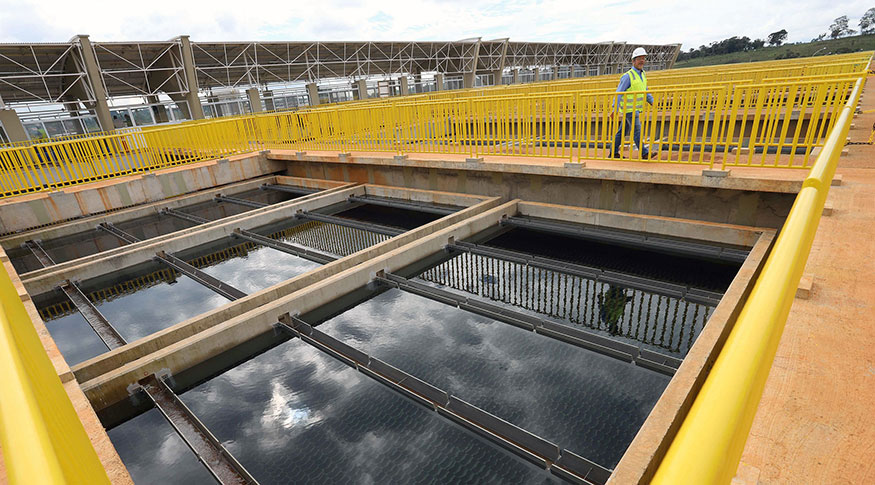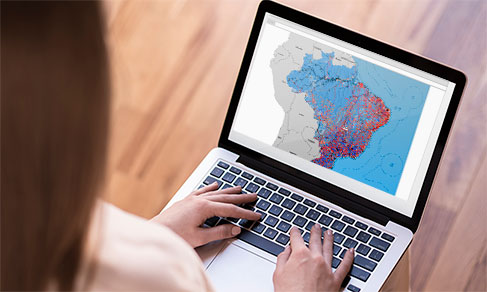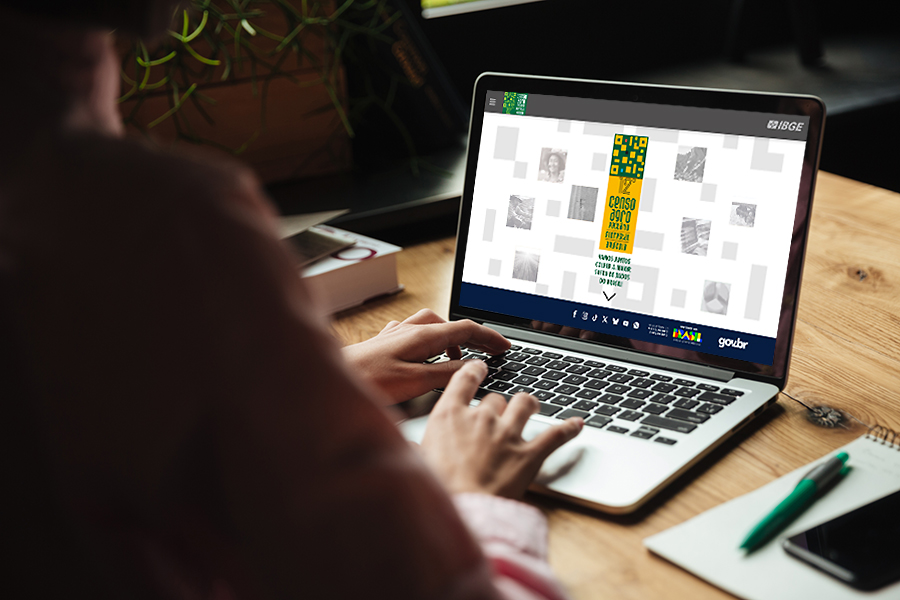Basic sanitation
Private companies are in charge of water supply in only 3.6% of the municipalities
July 22, 2020 10h00 AM | Last Updated: July 23, 2020 03h36 PM
Highlights
- Entidades públicas executaram serviço de abastecimento na maioria dos municípios; em apenas 3,6% empresas privadas têm esse papel.
- Cerca de 9,6 milhões de domicílios brasileiros não tinham acesso à água por rede de distribuição, metade estava localizado no Nordeste.
- Um em cada cinco municípios sofreram com o racionamento de água.
- 88,3% dos municípios trataram a água, mas quase 40% da água tratada foram perdidos durante a distribuição para os consumidores.
- Em 72,6% das cidades havia isenção ou descontos nas contas de água para famílias vulneráveis, beneficiando 2,8 milhões de famílias.
- Menos de 30% dos municípios possuíam quadro técnico para gerir abastecimento de água.
- Quase dois terços das cidades tinham órgão de fiscalização da qualidade da água em 2017.
- Menos da metade (44,7%) das cidades possuía legislação municipal para a proteção de mananciais.
- Os dados são de 2017 e fazem parte da Pesquisa Nacional de Saneamento Básico e do Suplemento de Saneamento da Pesquisa de Informações Básicas Municipais.

The participation of private companies in the execution of water supply services by means of a general system in the country fell from 4.5% of the municipalities, in 2008, to 3.6% in 2017, according to data from the National Survey of Basic Sanitation (PNSB), released today by the IBGE. In only 200 cities were services rendered by private companies. In the other municipalities, supply was a duty of city governments and public sanitation companies.
“Decrease was mainly due to a movement of "reestatization" initiated in the state of Tocantins, where, in 2008, 126 municipalities had services rendered by a private entity, versus only 52 municipalities in 2017”, says the survey manager, Fernanda Malta.
There was also reduced participation of private entities in the service, as well as a decrease in the number of municipalities in which the city government was responsible for water supply. On the other hand, the number of cities with municipal authorities, usually called Autonomous Water and Sewarage Services (SAAEs), and of state companies in charge of water supply recorded an increase.
According to the survey, no privatization process of the service is indeed in progress in the cities, but other forms of privatization - not investigated by the survey - should be considered.
“In some states, services under the responsibility of the state company were delegated to private companied, by means of public-private partnerships. The advance of privatization is also observed as there is an increase of the private sector participation in the shares of capital companies, a phenomenon that cannot be detected with the data we have”, Ms. Malta adds.
Almost all the municipalities have the service, but one out of every five still goes through water rationing
The PNSB shows that, in 2017, among the 5,570 Brazilian municipalities, including the Federal District and the state district of Fernando de Noronha, 5,517 (99%) had water supply services by means of a general system in operation and conducted at least by one executing agency. In 31 cities, the service was being implemented or had been stopped, and, in 22, it did not exist. That was observed in 13 cities in the Northeast, six in the North and two in the Central West.
Although most of the municipalities had the service, about 9.6 million housing units in Brazil still did not receive water from a water supply system. Half of them were located in the Northeast (4.8 million), followed by the North (2.7 million). The Southeast (912.8 thousand), South (703.1 thousand) and the Central West (491.2 thousand) had the smallest proportions of municipalities without water supply.
The survey also showed that the interruption of water supply took place in 44.5% of the municipalities, by six or more hours, whereas rationing affected 20.8% of the cities. These problems were most common in the Northeast, where 67.7%of the municipalities had intermittent supply and 42.5% reported having had water rationing.
"The distribution of treated water reaches most of the cities, but universalization of the service still does not exist", says Fernanda Malta.
In 93.5% of the municipalities with services in operation, water abstraction took place in the same city. In all the municipalities in the North, Southeast and South, and in the majority of those in the Central West, the agencies abstracted fresh water. A very small percentage of those areas caught also brackish, salt or saline water, with a total 2.7% in volume.
The Northeast is a highlight regarding the use of such sources in 26.5% of the municipalities, and that can be due to the little availability of fresh water in some areas. In the other major regions that percentage was of 1.6% at most.
Almost half of the municipalities in Rio Grande do Norte (49.1%) abstracted brackish, salt or saline water. The percentage was also high in Ceará (47.5%), Paraíba (34.0%), Piauí (31.5%) and Bahia (30.2%). In Rondônia, Acre, Amazonas, Roraima, Amapá, Rio de Janeiro, Paraná nd the Federal District no executing agency abstracted water in such conditions.
Brazil loses almost 40% of the treated water during distribution
Among the municipalities with services in operation, 4,873 (88.3%) abstracted water. The Central West (97.6%) and the South (97%) had the biggest percentages of municipalities with Water Treatment Stations (ETA) or Simplified Treatment Units (UTS), whereas the Northeast had the smallest percentage, with water treatment in 75.8% of the cities.
From all the water treated in the country, about 38.9% was lost in the process before reaching the consumer, according to the PNSB. The highest indexes of loss were registered in the North (48.3%) and in the Northeast (44.5%) of the country. In the Southeast, South and Central West, the percentages were smaller, but above 30%.
Exemption or discounts in the water bill benefited 2.8 million families
Since 2008, most of the municipalities (94%) have charged for water supply. That had changed little by 2017 (94.6%). Considering cities that do not charge for the service, more than half is located in the Northeast Region. The North has the smallest percentage of cities charging for the service (86.1%). In Acre, Amapá, Sergipe, Espírito Santo, Paraná, Rio Grande do Sul and Mato Grosso do Sul, all the municipalities with active services charged for them.
In 2017, 72.6% of the municipalities offered exemption from taxes or discounts in the water bill, a measure that benefited about 2.8 million families. The most common criterion for receiving the benefit was enrollment in social programs, such as Bolsa Familia, for example, followed by characteristics of the housing unit and earnings of the user and their family.
“This economic social policy instrument was less present in municipalities of the North where there were charges. The Northeast Region was a highlight in relation to water supply services, for which some users received subsidies in 79.2% of the municipalities, ” the survey manager added.
A little more than half of the city governments had proper structure for water management
The IBGE also released today (22) the Sanitation Supplement of the Survey of Basic Municipal Information (Munic) 2017, which collected information about the existence of the water supply only under control of municipal governments which, according to the law are responsible for water supply in the cities, and given the choice of sharing the service with or of delegating it to another entity.
According to the survey, from the total municipalities with water supply services, 54.8% had an organizational management structure, but in 2,509 of them the structure was linked to the city government, and in 530, to indirect public administration, formed mainly by autonomous municipal water and sewage departments and services. The remainder did not have a municipal body for management of the service or did not provide information, as it is the case of Rio de Janeiro.
In 2.9% of the municipalities, water supply services had an exclusive administrative secretariat. In most of the cities (71.8%), the sector was linked to other departments, mainly to Construction Works or the Environment. In 7.8% of the cities the service was under the Executive Power and in 17.5%, to an indirect administration body.
“More than 60% of the cities with over 20 thousand residents reported having a municipal body in charge of the service, reaching 71.4% in cities with more than 500 thousand residents. The Northeast was a highlight among the Major Regions with the biggest percentage of municipalities having such structure (59.3%),” Vânia Pacheco, manager of Social Studies and Surveys, says.
Less than 30% of the municipalities had technicians to manage water supply services
Only 28.4% of the municipalities had a technical staff in the city government for water supply services. The bigger the population of a municipality, the bigger the percentage of city governments with a specialized staff. Among the Major Regions, the Central West (30.1%) and the Northeast (30%) stand out. That was mainly observed in the cities that had an exclusive secretariat or body in the public administration for water supply.
The survey also reported the existence of municipal regulation for the protection of water sources in 44.7% of the cities. It also observed that in 63.9% of the municipalities there was a law for the approval and implementation of a water supply system for new lots. Another aspect presented was the existence of a municipal body in charge of the supervision of water quality in 64.7% of the cities. The laws and the supervision agency were most common in municipalities in the South and less in the Northeast.
In 68.4% of the cities that had a municipal body for water supply management, the city government executed the service, being alone in 40.4% of the cities and in partnership with other cities in 28% of the cities. In the other municipalities (31.6%), another entity executed the service without participation of the city government.
When water supply is executed by another entity, there must be a legal instrument for delegation of the service. According to the survey, in 4,218 municipalities with executing agencies other than the city government, the most common instrument was the concession contract, present in 3,059 cities. Other common instruments were the program contract and the partnership agreement. In 471 municipalities, most of them in the Northeast, there was no service delegation.

















